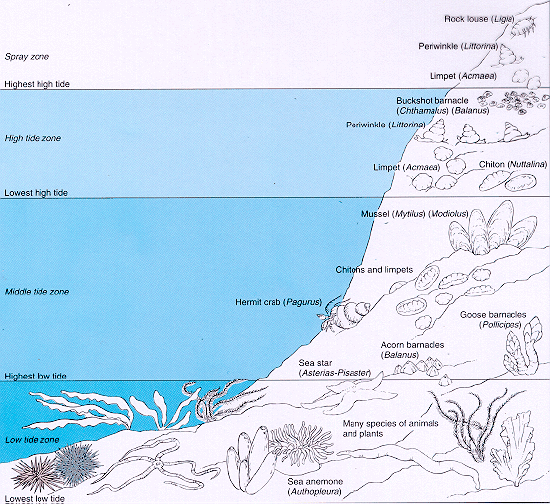12.7 Rocky Shore
- Page ID
- 1107
The incredibly diverse Rocky Intertidal Ecosystems are located on rocky shores ranging in the area of land that is exposed between high and low tide. This is a very extreme environment that has selected for organisms that are uniquely adapted to tolerate both exposure to air and high wave action, among other physical environmental factors. Frequent disturbance makes this a stressful habitat to live in, but intensity of stress varies among the high-, mid-, and low-intertidal zones. The high-intertidal zone, ending at the landward region of the intertidal zone, experiences the most extreme conditions and can be exposed to air and sunlight for long periods of time between high and low tide. Organisms that live in this region, including barnacles, limpets, chitons, and other encrusting species, are tough critters that have to withstand desiccation (loss of water) and sun exposure (over-heating).  The mid-intertidal zone experiences the most frequent disturbance because it is submerged and exposed while the tide goes out and comes back in. In geographic areas that have semi- or mixed-diurnal tides, such as the western coast of the US, intertidal zones are exposed to two high and two low tides per day. This subjects organisms living in the mid-intertidal zone, including mussels and fucoid algae, to four periods of intense wave action per day. These organisms must develop strong attachment techniques to avoid dislodgment from the rocky shore, which would ultimately lead to death. The low-intertidal zone, the least stressful zone that is submerged in water for the majority of the day, is home to eel grass, sponges, and tunicates. Without the imminent threat of forceful waves, many delicate invertebrates thrive in the low intertidal.
The mid-intertidal zone experiences the most frequent disturbance because it is submerged and exposed while the tide goes out and comes back in. In geographic areas that have semi- or mixed-diurnal tides, such as the western coast of the US, intertidal zones are exposed to two high and two low tides per day. This subjects organisms living in the mid-intertidal zone, including mussels and fucoid algae, to four periods of intense wave action per day. These organisms must develop strong attachment techniques to avoid dislodgment from the rocky shore, which would ultimately lead to death. The low-intertidal zone, the least stressful zone that is submerged in water for the majority of the day, is home to eel grass, sponges, and tunicates. Without the imminent threat of forceful waves, many delicate invertebrates thrive in the low intertidal.
Online resources
- oceanspaces.org/monitoring/ec...dal-ecosystems
- http://montereybay.noaa.gov/sitechar/rock3.html
- http://dusk.geo.orst.edu/oceans/intertidal.html
- www.bbc.co.uk/nature/habitats/Intertidal_zone

